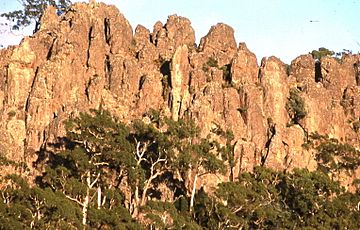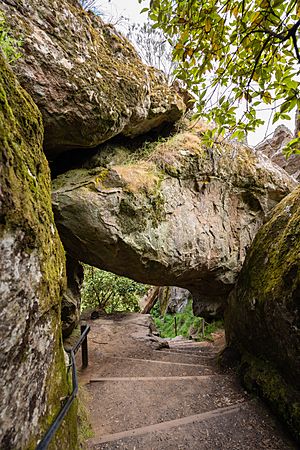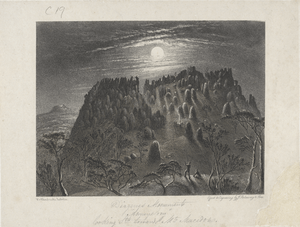Hanging Rock, Victoria facts for kids
Quick facts for kids Hanging Rock(Ngannelong) |
|
|---|---|
 |
|
| Highest point | |
| Elevation | 718 m (2,356 ft) AHD |
| Prominence | 105 metres (344 ft) above plain |
| Geography | |
| Parent range | Macedon |
| Geology | |
| Age of rock | 6.25 million years |
| Mountain type | Mamelon |
Hanging Rock (also called Mount Diogenes or Ngannelong by its traditional owners) is a unique rock formation in central Victoria, Australia. It was once a volcano! It stands 718 meters above sea level. This is about 105 meters higher than the flat land around it.
Hanging Rock is located between the small towns of Newham and Hesket. It is about 70 kilometers north-west of Melbourne. It's also just a few kilometers north of Mount Macedon.
For thousands of years, Aboriginal people lived around Hanging Rock. These included the Dja Dja Wurrung, Woi Wurrung, and Taungurung tribes. In the mid-1800s, they were forced to leave their land. Even so, they still have strong cultural and spiritual ties to this special place.
Later, for European settlers, Hanging Rock became a popular spot for fun and tourism. It has been managed by private owners, the government, or a mix of both.
In the late 1900s, the area became very famous. This was because of Joan Lindsay's novel Picnic at Hanging Rock.
Contents
What's in a Name?
It has been hard to find the original Aboriginal name for Hanging Rock. Some people thought it was "Anneyelong." This was because of a note under an old drawing of the rock from 1855–56. But historians now think the artist, William Blandowski, might have misheard the name. They believe the real name was likely "Ngannelong" or something similar.
In 1843, a surveyor named Robert Hoddle called the rock "Diogenes Mount." This name fit with other ancient Macedonian names given by Major Thomas Mitchell during his trip through Victoria in 1836. Other places he named include Mount Macedon and Mount Alexander. Hanging Rock has had several other European names too, like Dryden's Rock.
How Hanging Rock Formed
Hanging Rock is a type of volcano called a mamelon. It formed about 6.25 million years ago. This happened when thick, sticky lava pushed up from deep underground. It cooled and hardened right where it was.
Many people think it's a volcanic plug, but it's actually different. Two other mamelons are nearby, formed at the same time. One is Camels Hump on Mount Macedon. The other is Crozier's Rocks to the east. All three of these rock formations are made of a type of rock called soda trachyte.
As the lava that formed Hanging Rock cooled, it shrank. This caused it to crack into rough columns. Over millions of years, wind and rain wore these columns down. This created the many tall, pointy rocks you see today.
These three mamelons also help us understand how plate tectonics works. The Earth's surface is made of huge plates that slowly move. Australia's plate moved north over a "hotspot" deep inside the Earth. This hotspot created a chain of volcanoes over 27 million years. Hanging Rock is at the very southern end of this chain.
Hanging Rock has many cool rock shapes. These include the "Hanging Rock" itself, which is a big boulder stuck between others. This is where the main path goes. Other formations are called the Colonnade, the Eagle, and the UFO. The highest point of Hanging Rock is 718 meters above sea level.
Traditional Owners and History
Before European settlers arrived, the traditional owners had lived around Hanging Rock for over 26,000 years. The Rock was a very important part of their culture and way of life. Sadly, they were forced to leave the area.
Jason Tamiru, a Yung Balug person, shares how important this place is:
- "This is a place where big business was held: Corroborees, Initiation Ceremonies, Songline Ceremonies, trade and relationship building and a place where laws were made and passed."
- He also says, "The mystique and spiritual essence of the rock has contributed to the story of our Dreaming which binds my people to our creator spirits and country."
- "We Sing, Dance and Paint our Country forever."
Even after Aboriginal people were forced from their land, they continued to connect with Hanging Rock. One of the last important ceremonies may have happened there in November 1851. An engraving from 1855/56 shows Aboriginal people camped on the hillside. Another drawing from 1865 shows three Aboriginal figures with Hanging Rock in the background. These images remind us of their long history with the land.
Community and Activities
Hanging Rock is a popular place for many activities. Horse races have been held there for over 100 years. The Hanging Rock Racing Club has two races each year, on New Year's Day and Australia Day (January 26).
The Friends of Hanging Rock is a group that started in 1987. They hold events for the public, like planting trees and tours to see local wildlife.
In 2013, a group called the Hanging Rock Action Group was formed. Local people were worried about plans to build a large conference center and hotel near the Rock. They wanted to make sure the community had a say in these decisions.
Hanging Rock is the main feature of the Hanging Rock Recreation Reserve. This is a public park managed by the Macedon Ranges Shire Council. The reserve has a horse racing track, picnic areas, a creek, a visitor center, and a cafe. It is also home to many native animals like koalas, wallabies, possums, and kookaburras.
There's also a fun "Picnic at Hanging Rock" event in February. People dress up in old-fashioned clothes from the Victorian or Edwardian times. They have a picnic at the bottom of the Rock and then climb up for photos.
The reserve is open to visitors every day during daylight hours. There is a small fee per car to enter. You can also arrange to camp there.
Hanging Rock Reserve is very important to Victoria. It is listed on the Victorian Heritage Register for its history, beauty, and social meaning.
The Story of Picnic at Hanging Rock

Hanging Rock was the inspiration for the famous novel Picnic at Hanging Rock. Joan Lindsay wrote this book in 1967. The story is about some schoolgirls who disappear during a visit to the Rock. The mystery of their disappearance made the book very popular. The author actually wrote an ending that explained what happened, but she decided to remove it. She thought the story was better as a mystery.
The novel was made into a film in 1975, directed by Peter Weir. The movie was a big hit and made many more people want to visit Hanging Rock. It also brought new interest to the book. Later, in 1980, Yvonne Rousseau wrote a book called The Murders at Hanging Rock. It looked at different ideas about what might have happened to the girls.
After Joan Lindsay passed away, the ending she had removed from the novel was finally published in 1987. It was called The Secret of Hanging Rock.
Concerts at Hanging Rock
Hanging Rock Reserve is also used as a place for big outdoor concerts. Many famous international music acts have performed there as part of their tours in Australia.
Some of the artists who have played at Hanging Rock include:
- Leonard Cohen – November 2010
- Rod Stewart – February 2012 and March 2015
- Bruce Springsteen – March 2013 and February 2017
- Rolling Stones – November 2014 (after an earlier show was cancelled)
- The Eagles – February 2015
- Cold Chisel – November 2015
- Ed Sheeran – February 2017
- Midnight Oil – November 2017
- Elton John - January 2020
In 2013, a company called Frontier Touring made a deal to hold up to four concerts at Hanging Rock each year for five years.
Images for kids








